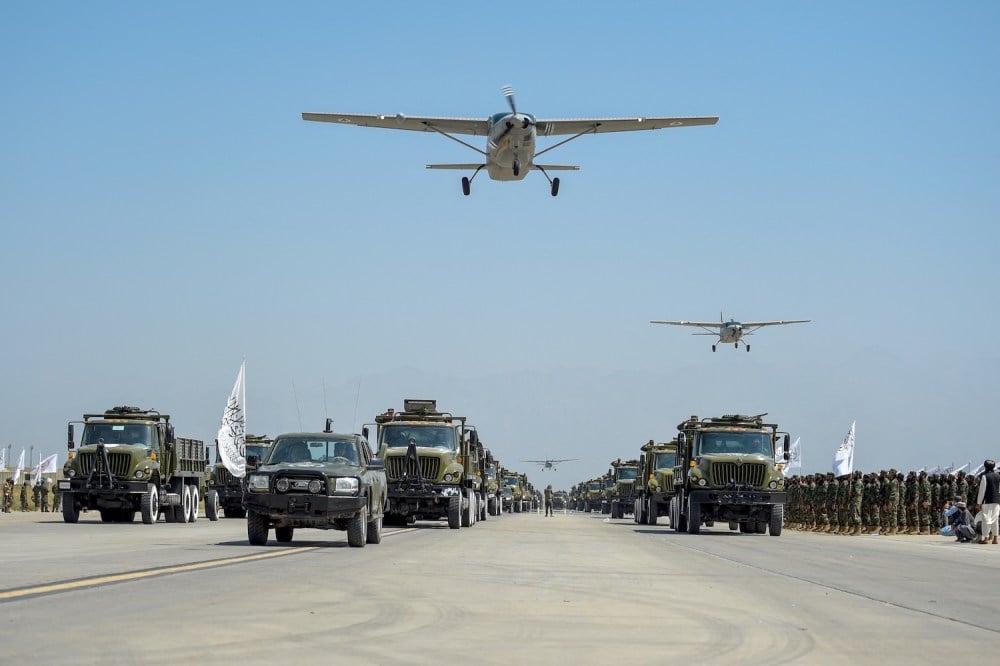
Welcome to Foreign Policy’s South Asia Brief.
The highlights this week: U.S. President Donald Trump escalates a demand that the Taliban hand over Bagram Airfield, South Asian leaders arrive in New York City for the U.N. General Assembly—with a notable exception, and India implements large tax cuts.
Trump’s Bagram Airfield Gambit
Over the weekend, U.S. President Donald Trump escalated a demand that he has made of the Taliban ever since the start of his second term. He warned in a Truth Social post that if the Taliban regime doesn’t return Bagram Airfield—a key U.S. military base during the war in Afghanistan—to the United States, “BAD THINGS ARE GOING TO HAPPEN!”
Everything about Trump’s demand—the timing, the justification, and now the threat—is hard to make sense of. The Taliban reject the presence of foreign military forces on Afghan soil. While the regime has proved willing to make concessions to Washington to gain legitimacy, including the release of U.S. hostages, the Bagram issue is a red line. The Taliban rejected Trump’s demand on Sunday.
The timing of Trump’s statement was strange. U.S. hostage envoy Adam Boehler and former U.S. special representative for Afghanistan reconciliation Zalmay Khalilzad recently made their second trip to Kabul since Trump took office to discuss prisoner releases with Taliban leaders. These talks are sensitive; with the threat, Trump risks botching what is arguably the administration’s chief policy priority in Afghanistan.
Trump’s stated reason for wanting Bagram in U.S. hands is the base’s close proximity to Chinese nuclear weapons facilities. But it seems that returning U.S. personnel to the base after more than four years would imperil U.S. interests. After all, Beijing could view the retaking of the base as a provocation, inviting possible retaliation. There is also a broader irony: China’s own footprint in Afghanistan is relatively light, mainly because of terrorism concerns.
There is probably an unstated reason why Trump seeks Bagram: wanting a position from which to monitor the Islamic State-Khorasan (IS-K). The Afghanistan-based affiliate of the Islamic State increasingly poses a global threat, including a few foiled plots in the United States, according to U.S. officials. (Still, given indications of the group’s growing clout beyond Afghanistan, U.S. counterterrorism might be better focused elsewhere.)
For its part, the Taliban—which has sought to curb IS-K with aggressive ground operations—would say that the United States could keep an eye on the threat by reopening its embassy in Kabul. The need to monitor terrorism concerns was a likely motivation for several countries, including India, to maintain a diplomatic presence on the ground after the Taliban takeover in 2021.
It is unlikely that the United States would reopen its embassy, but it does have open channels with the Taliban, resulting in periodic meetings in Qatar and a few others in Kabul. These open channels give Washington other opportunities, such as testing the viability of gaining influence over Afghan critical minerals. The U.S. intelligence community may also have informal links with the Taliban to discuss shared IS-K concerns.
It’s unclear whether Trump’s latest threat is a bluff or something more, though his repeated calls for Bagram Airfield suggest that he genuinely wants it. The most extreme scenarios could include staging a very risky military takeover of the base or even destroying it. Either plan could risk the loss of Afghan and American lives, set back talks on prisoners, and cost Trump politically.
So Trump is making a demand that the Taliban will likely never accept, while seemingly ignoring policy options that would better address U.S. strategic and security concerns in Afghanistan.
What We’re Following
South Asia at UNGA. Some of the region’s top leaders arrived in New York City this week for the high-level week of the U.N. General Assembly (UNGA). Pakistan, serving a two-year term as a nonpermanent member on the U.N. Security Council, will likely use the meetings to build on efforts to focus global attention on the Kashmir dispute. Pakistani media has reported that Prime Minister Shehbaz Sharif will travel to Washington on Thursday to meet Trump.
Meanwhile, interim Bangladeshi leader and Nobel laureate Muhammad Yunus will spend a long time at the U.N. He left for New York on Monday and is expected to remain until Oct. 2. With elections scheduled in Bangladesh for February, this will be Yunus’s last UNGA visit as leader. He will want to draw on his star power one more time to highlight urgent challenges facing his country, including the Rohingya refugee crisis.
Other top South Asian leaders at UNGA include Sri Lanka’s Anura Kumara Dissanayake, who is attending for the first time as president. It’s unclear if the region’s newest leader, interim Nepali Prime Minister Sushila Karki, will be present this week.
Indian Prime Minister Narendra Modi is a notable absence; External Affairs Minister S. Jaishankar is at UNGA instead. This means that there is no opportunity for Modi and Trump to clear the air, as their relationship has suffered fresh blows in recent days. However, on Monday, Jaishankar met separately with U.S. Secretary of State Marco Rubio and Sergio Gor, the Trump administration’s newly appointed special envoy for South Asia.
India implements large tax cuts. Many Indian staples—including milk, bread, lifesaving drugs, and medical insurance—became tax free on Monday, part of a broader goods and services tax overhaul. Taxes on small cars, televisions, and air conditioners will fall from 28 percent to 18 percent, among other reductions. Modi announced the latest moves in an address to the nation on Sunday; they are meant in part to help Indians withstand the shock of 50 percent U.S. tariffs.
But the tax reductions could also help address sluggish household consumption rates, especially in urban areas. Along with unemployment, these consumption woes have been a persistent economic challenge. These rates account for more than half of India’s total GDP. Still, economists also worry that the tax cuts could slash Indian government revenue by about $5.4 billion this year.
There is likely a political angle. India’s festival season is approaching, a time when families ramp up their spending. New Delhi likely hopes that the tax cuts will boost consumption as well as reducing stress among the public about their spending.
Pakistan-Saudi Arabia defense pact. The landmark Pakistan-Saudi Arabia mutual defense pact announced last week was likely mostly motivated by strategic issues in the Middle East, not South Asia. But the deal is fraught with significance for India, given its own close relationship with Saudi Arabia—and the fact that India would be the most likely country to attack Pakistan in the future.
An Indian attack on Pakistan still isn’t very likely to provoke a Saudi military response, but the new pact may push Riyadh to call for de-escalation more quickly than it has in the past. Taken alongside Pakistan’s alliances with other key powers—China and Turkey, plus warming ties with the United States—the agreement will also prompt concern within the Indian strategic community.
The broader implications for New Delhi’s relationship with Riyadh are unclear, though CNBC reported that Saudi oil exports to India—a critical component of the bilateral relationship—should not be affected. Since it stopped importing Iranian oil due to U.S. pressure, India has increased energy cooperation with Saudi Arabia and its Gulf allies in recent years.
One can expect India to seek some high-level engagements with senior Saudi officials, perhaps as early as this week during UNGA meetings, to get more clarity about what the new defense pact means for India, from the Saudi perspective. New Delhi has said little publicly, though last week, it advised Riyadh to consider “mutual interests and sensitivities.”
FP’s Most Read This Week
The End of Development by Adam Tooze
America’s Infuriating and Irreplaceable Role at the U.N. by Richard Gowan
Trump Is Learning Geopolitics in Real Time by Suzanne Nossel
Under the Radar
Pakistan’s national human rights council said it was “deeply shocked” by reports of “a number of civilians, including children” killed by Pakistani airstrikes on Monday in the Tirah area of Khyber Pakhtunkhwa province, near the border with Afghanistan.
Some journalists posted more information on social media, including one report on X indicating that around 25 people, mostly women and children, were killed in strikes on five homes. Local residents held a sit-in on Monday in protest. Pakistani officials say that an explosion of militants’ bomb-making materials caused the deaths; this doesn’t track with local accounts—including comments from police—that point to an aerial assault.
Pakistani security forces have intensified operations against militants along the border with Afghanistan amid attacks against soldiers by Tehreek-e-Taliban Pakistan (TTP). But Pakistan’s military often uses scorched-earth tactics in the border region, invariably causing civilian casualties and stoking local anger among Pashtun communities.
Another risk for civilian and military leaders is that this reported tragedy could be politically damaging. The Khyber Pakhtunkhwa government is run by the opposition Pakistan Tehreek-e-Insaf (PTI) party. Provincial leaders, along with other senior PTI leaders, have wasted no time in criticizing the incident and the security forces that they say were behind it.
If PTI is able to mobilize protests in the province that target national leadership, it could damage the goodwill that the Pakistani government and military regained from the broader public after Pakistan fended off Indian attacks during their May conflict.



